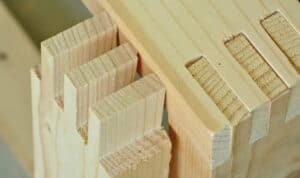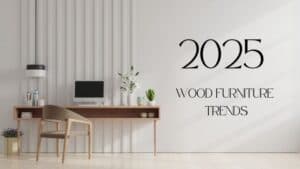Wooden outdoor furniture adds a touch of natural beauty and warmth to any patio, deck or garden. From classic Adirondack chairs to elegant teak dining sets, wood is a popular choice for its timeless appeal and versatility. However, leaving wooden furniture exposed to the elements can take a toll, leading to cracking, warping, fading, and decay over time.
While wood is inherently susceptible to weathering, there are steps you can take to protect your outdoor furniture and keep it looking beautiful for years to come. The key is understanding how different weather conditions affect wood and using the right techniques to seal, stain and care for your pieces.
In this article, we’ll explore the benefits and vulnerabilities of various types of wood commonly used for outdoor patio furniture. We’ll also provide expert tips on how to weatherproof and maintain wooden furniture to maximize its durability and resistance to moisture, UV rays, and temperature changes. Whether you’re looking to spruce up existing pieces or invest in new wooden outdoor furniture, these insights will help you make your wood furnishings last.
Which Kind of Wood Furniture is Suitable for Outdoor Using

When you’re selecting wood furniture for your outdoor space, durability and weather resistance are key. Here’s what you should consider:
- Cedar: A top choice due to its natural resistance to rot and insects. Cedar furniture adorns outdoor settings with a lovely silver-grey patina over time.
- Teak: Famous for its toughness, teak resists weather conditions brilliantly, making it an ideal choice for outdoor furniture. It also maintains its appearance with minimal care.
- Redwood: Great for outdoor use because of its natural oils that resist decay. Its rich color adds warmth and elegance to your garden or patio.
- Cypress: Valued for its natural preservative oil, cypress furniture can withstand the elements, and it possesses a distinctive appearance that stands out among hardwoods.
- Acacia: Known for its hardness and durability, acacia is an excellent sustainable option that copes well with the outdoor environment.
- Eucalyptus: A dense wood that’s sustainably harvested, eucalyptus offers a cost-effective alternative with good durability for outdoor use.
The Different Impacts of Climate on Wooden Furniture

Wooden furniture is sensitive to the moisture and temperature conditions of its environment. Humidity extremes and rapid changes in temperature throughout the seasons cause wood to constantly shrink, swell, warp and crack. UV rays also can break down wood fibers leading to fading.
When the air is humid, wood absorbs moisture and swells. When the air is dry, wood loses moisture and shrinks. Excessive humidity above 60% can cause damage to wood like mold, mildew, and rotting.
Extreme temperatures, both hot and cold, can damage wooden furniture. Freezing temperatures can cause wood to crack and warp.
High temperatures can cause wood to dry out and split. Rapid fluctuations between hot and cold cause expansion and contraction cycles that can lead to warping and cracking over time.
How to Protect the Wooden Furniture from Weather Damage
1. Apply protective coatings
- Use a high-quality outdoor wood sealant, stain, varnish, or paint to create a barrier against moisture, UV rays, and other damaging elements.
- Clean the wood thoroughly and sand it smooth before applying the protective coating. Follow the manufacturer’s instructions for application and recoating.
- Refinishing is important. Reapply the sealant or coating every 1-2 years or as needed to maintain protection.
2. Cover the furniture when not in use
- Use waterproof furniture covers, tarps, or awnings to shield the wood from rain, snow, and harsh sunlight when the furniture is not being used.
- Store the furniture indoors, such as in a shed or garage, during the off-season or extreme weather to prevent prolonged exposure.
3. Provide shelter
- Position wooden furniture under a covered patio, pergola or umbrella to protect it from direct sunlight and precipitation when possible.
- Avoid placing wooden furniture too close to heat sources like fireplaces or heating vents which can dry out and damage the wood.
4. Clean and maintain regularly
- Wipe down wooden furniture with a soft, dry, or slightly damp cloth to remove dirt, pollen, and debris. Avoid using harsh cleaners.
- Inspect the furniture regularly for any cracks, warping, fading, or signs of rot. Make repairs promptly to prevent further damage.
- Consider using furniture glides to raise wood slightly off the ground to prevent moisture from pooling underneath.
How to Protecting the Fiber on Outdoor Furniture

When you repurpose indoor furniture for your outdoor oasis, selecting the right fabric is crucial. Outdoor fabrics come with a protective treatment that helps them resist moisture and mildew. This feature is vital since fabrics in outdoor settings are exposed to various weather elements.
- Choose Your Fabric:
- Look for outdoor-specific fabrics which are designed to withstand sun exposure and prevent water from soaking in. These materials come in a variety of patterns and colors, so you’re likely to find something that fits your style.
- Alternative Solutions:
- If you can’t find an outdoor fabric you love, consider using a waterproofing spray as an alternative. Apply it to your standard fabric to add a moisture-resistant layer.
- Upholstering:
- With the right fabric in hand, reupholster your cushions and pillows. Make sure to cover all surfaces thoroughly, without gaps where moisture could penetrate.
- Care and Maintenance:
- Regular maintenance, such as cleaning off dirt and storing cushions away during severe weather, will extend the life of your outdoor fabrics.
Frequently Asked Questions
Is there a way to convert an indoor sofa for outdoor use?
To convert an indoor sofa for outdoor use, replace the fabric with weather-resistant varieties such as solution-dyed acrylics. You’ll also want to treat the wood frame with water-repellent preservatives and a durable top coat. Ensure the cushions have open-cell foam or are wrapped in a water-resistant barrier that allows for quick drying.
What is the process of permanently waterproofing wood?
Permanently waterproofing wood involves applying a mix of oils and resins that penetrate wood fibers to create a moisture barrier. Look for marine-grade sealants for a more durable finish. Such products are designed for boats and are exceptionally good at protecting wood in high moisture environments like the outdoors.
What are the popular sealants used on wooden furniture?
Polyurethane and lacquer provide the most durable finishes, while oils and waxes give a more natural look but require more upkeep. Testing the sealant on a small, inconspicuous spot is always recommended before applying it to the entire piece.
- Polyurethane
- Available in both oil-based and water-based formulas
- Provides a durable, protective finish that resists scratches
- Won’t yellow over time, even on light-colored woods
- Oil-based polyurethane is very durable but requires mineral spirits for cleanup; water-based dries quickly but is less durable
- Polycrylic
- A water-based sealer that is fast-drying and has low odor
- Versatile and can be used on floors, furniture, and artwork
- Good choice for sealing painted furniture as it is less likely to yellow
- Not as durable as polyurethane
- Lacquer
- Offers a variety of sheen options (matte to glossy)
- Dries very quickly and can be re-coated in a short time
- Good choice for deep-toned woods but can yellow lighter woods over time
- Lacquer thinner can be used to adjust the consistency
How do I use indoor furniture outside my home?
To safely use indoor wooden furniture outdoors, choose solid wood pieces and avoid precious items. Sand the furniture, apply exterior primer, and then paint with multiple coats of exterior paint suitable for the furniture. Allow ample drying time.
Seal thoroughly with a high-quality outdoor sealant like spar varnish or exterior polyurethane, covering every surface. Position the furniture under a covered area when possible and use furniture covers when not in use.
Maintain regularly by reapplying sealant or paint every 1-2 years and cleaning often. While not as long-lasting as outdoor furniture, indoor pieces can be enjoyed outside with proper preparation and care.






